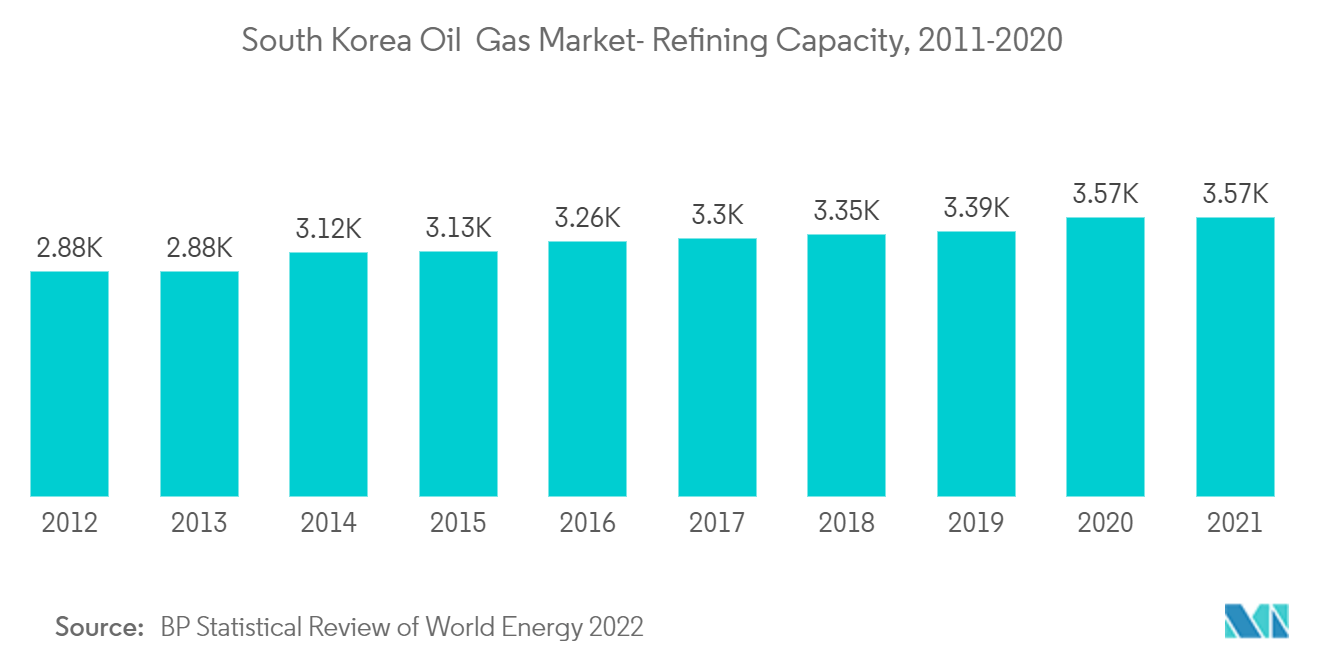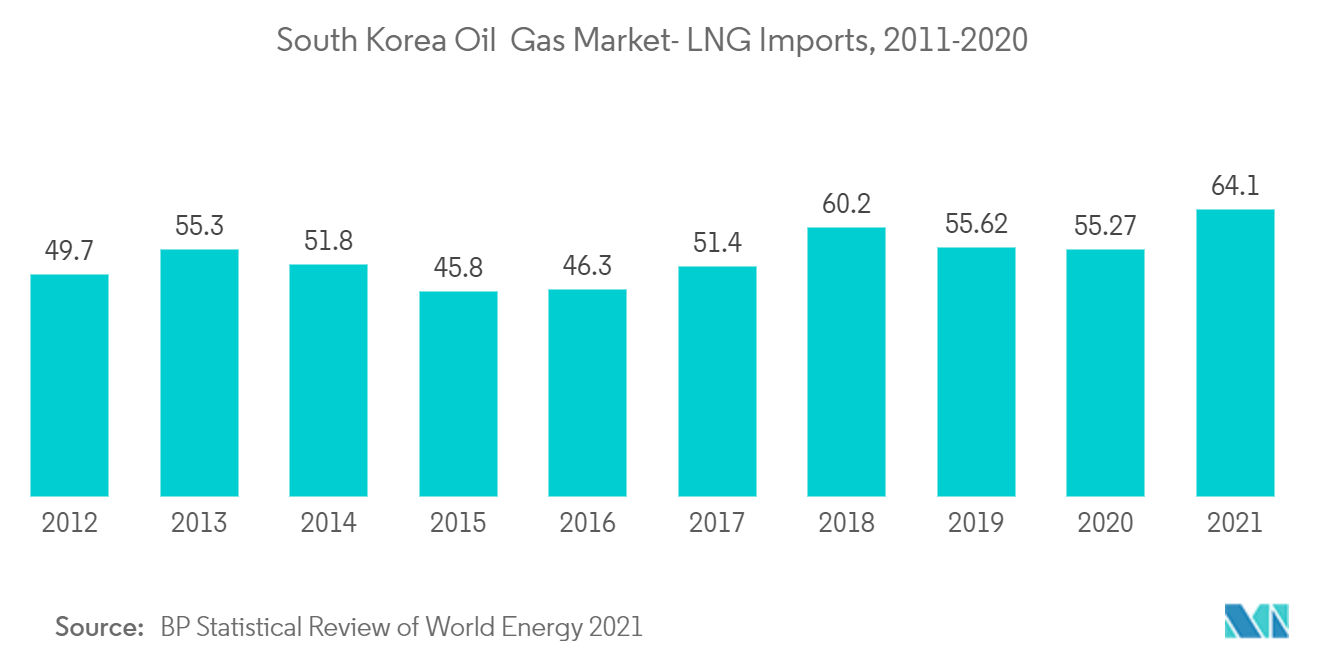Market Trends of South Korea Oil & Gas Industry
This section covers the major market trends shaping the South Korea Oil & Gas Market according to our research experts:
Downstream segment to dominate the market
- The Downstream segment of the South Korea Oil & Gas market is one of the most well-developed segments in the world, and the country is home to some of the biggest and most advanced oil refineries globally.
- In 2021, the country had a refining capacity of 3,572 thousand barrels per day,unchanged from 2020. No large-scale expansion or modernisation projects or new refineries are planned to come online in the next several years.
- One of the primary factors driving the downstream sector is the demand for refined products such as gasoline and diesel in the transportation sector and the demand for other petroleum derivatives such as ethylene for the production of chemical products and polymers, and increasing the export of chemicals and polymers to other nations.
- In August 2022, Kumho Petrochemical announced that it planned to invest nearly KRW 3.3 trillion in its core business areas for expanding production capacity of nitrile butadiene latex (NB latex) and styrene solution butadiene rubber (SSBR) over the next 5 years.
- In September 2021, DL Chemical Co., the petrochemical arm of South Korea's DL Group, announced its plan to spend KRW 2 trillion (USD 1.7 billion) over the next five years to boost its production capacity, which will include additional production capacity from mergers and acquisitions. DL Chemical is planning to transform itself into a manufacturer of high-value speciality chemicals used in sectors such as construction and electronics, which have been enjoying high demand.
- LG Chem Ltd., South Korea's top chemical manufacturer, announced in August 2021 that it plans to spend KRW 2.6 trillion (USD 2.2 billion) to strengthen its green business portfolio as it steps up efforts to transform into an eco-friendly company. With the investment, the company will build 10 new chemical factories in Seosan, South Chungcheong Province, mainly producing biodegradable materials and other sustainability-focused chemical products. The company plans to begin commercial operations for PBAT (polybutylene adipate-co-terephthalate) factory and a POE (polyolefin elastomer) plant by 2024.
- Such investment trends in the refining and petrochemical sector are expected to drive the downstream segment significantly during the forecast period.

Government efforts to reduce coal and nuclear consumption to drive the LNG -to-power segment and LNG imports
- Owing to the lack of domestic resources, South Korea remains dependent on gas imports to meet around 98% of its fossil fuel consumption. In 2020, South Korea imported 55.3 Billion Cubic Meters of LNG, witnessing a slight drop of 1% compared to 2019. Further, South Korea is the third-largest importer of LNG after Japan and China, accounting for about 11.3% of the total world's LNG imports. The country has no international oil or natural gas pipelines and relies exclusively on LNG and crude oil tanker shipments.
- According to South Korea's Basic Plan for Power Supply 2020-34, released in December 2020, the country will increase the capacity of LNG-based power plants by 43% to 59.1 GW in 2034 from 41.3 GW in 2020 while reducing coal-fired power plants and nuclear reactors. According to the plan, LNG-based power plants will have a capacity of 43.3 GW in 2022, 55. 5GW in 2030 and 59.1 GW in 2034.
- To reduce carbon emissions, under this plan, the country aims to close down 30 ageing coal-fired power plants, or half of its 60 coal-fired power stations currently under operation, by 2034. Of these 30 planned closures, 24 will be replaced by a combined capacity of 12.7 GW that will be converted into natural gas-fired power plants. This is expected to create long-term demand for LNG, boosting LNG import volumes, which is expected to drive the midstream sector during the forecast period.
- In January 2022, South Korea shut down 2 of its oldest coal-fired power plants, the 250 MW- Honam Coal Power Plant No. 1 and No. 2, built in 1973. The plants are expected to be replaced by 2 LNG-fired power plants and a hydrogen fuel cell power plant. These large-scale closures of coal-based thermal power plants are expected to create a massive demand for LNG during the forecast period.
- As of 2021, South Korea's state-run Korea Gas Corp (KOGAS) was one of the largest buyers of LNG, importing nearly 38.17 MT of LNG in 2021, up 19.6% from 2020, and accounting for almost 83.1%of the country's total LNG imports. As of 2021, KOGAS has 9 long-term contracts -- 9.02 MTPA in 3 contracts from Qatar, 4 MTPA from Oman, 3.5 MTPA from Australia, 2 million MTPA from Malaysia, 0.7 MTPA from Indonesia, 1.5 MTPA from Russia's Sakhalin, and 2.8 MTPA from the United States Sabin Pass.
- In April 2022, South Korea's state-run Korea Gas Corp (KOGAS) signed an 18-year sales and purchase agreement with BP Singapore Limited for importing 1.58 MTPA (Million tons per annum) of LNG starting from 2025.
- Such large-scale LNG purchase contracts are expected to create a demand for additional LNG handling and transport infrastructure, which is expected to drive the midstream segment during the forecast period.


